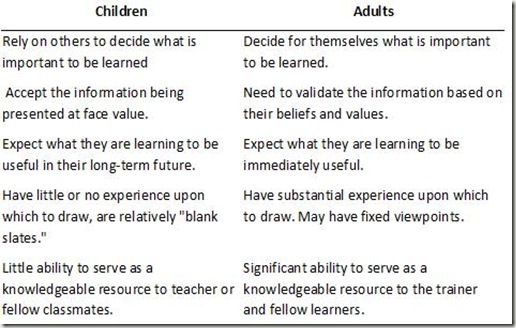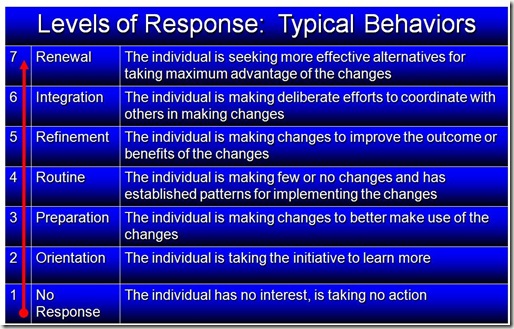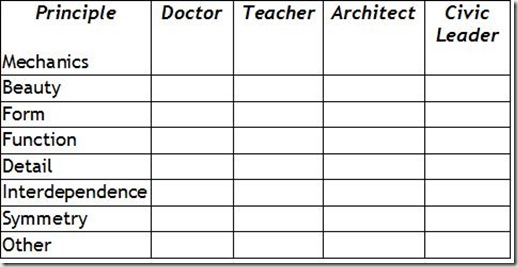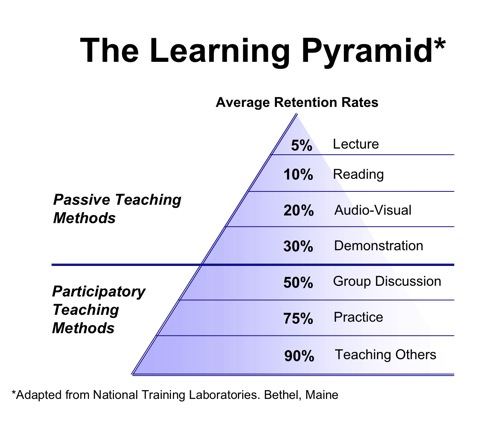Dr. Barrett Mosbacker, PublisherHere is the hard and sad truth: over the last several decades Christian schools have invested tens of thousands of hours and hundreds of thousands of dollars on staff
training programs and conferences but with little sustained impact. Despite all of the research, despite recent advances in neuroscience, notwithstanding the wide-spread availability of increasingly affordable and effective technologies, and despite our grandiose pronouncements, our classrooms are virtually indistinguishable from classrooms from the 1920's or 1950's. Only the furniture has changed.
We may have made changes at the margins, but systemic change is hard to find. There are teachers, scattered here and there, who exemplify the best in teaching. And there are a few schools that break the mold and provide paradigms for others to emulate. Sadly, most of these schools are not Christian--they are public or secular private schools. By in large, most Christian schools have hearts of gold while stuck in an industrial model of teaching that has little in common with a rich biblical understanding of the learner or the effective and consistent application of current research and technology.
A harsh indictment I know. It is nevertheless motivated by a deep love for Christian education and an insatiable desire to see our schools standing as beacons of excellence, schools characterized by creative nurturing environments, rigorous learning, thoughtful and informed dialog, problem-based learning, integrated technologies, and authentic assessment.
Why?
Why—despite our best intentions and the investment of substantial time and money—do our schools remain largely unchanged? There are many reasons. One of the most important is the relatively ineffective way we design and implement staff development programs. Most of our training programs go something like this; we have a week of training in which we discuss biblical integration or some other topic du jour. Most of the training is delivered like most teachers teach—didactic presentations, perhaps supplemented by PowerPoint slides. There is nominal interaction and virtually no immediate, real-time practice or application of the concepts covered. There is seldom follow-up or accountability. With the exception of yet another discussion of biblical integration (more on this later) topics and emphasis changes from year-to-year. Teachers sit through the presentations but little changes. School begins; teachers return to their classrooms close their doors and teach just like they always have. We return to our offices to deal with day to day exigencies. Within a month in-service is forgotten. Then, sometime in the spring, we plan for next year's in-service and the cycle begins again, just like the movie Groundhog Day.
Through this process, teachers learn that "this too shall pass." Teachers often view in-service as something to endure or a time to catch up on relationships. For most, it is not an occasion for deep reflection; it is seldom stimulating, and seldom leads to change in the classroom or systemic change in our schools. Each year we pick our in-service topic, throw it against the wall and hope it will stick. It usually doesn't.
I am not cynical but my observations arise from 20 years of attending conferences, conducting in-service training programs, and consulting with other schools. Too many of our teachers reflect the sentiments expressed in the following video:
Rethinking and Redesigning Staff Training
Good teachers are to education what education is to all other professions—the indispensable element, the sunlight and oxygen, the foundation on which everything else is built. They are central to assuring excellence and rigor in the educational experience of every young person in America (Milken, 2000, p. 3).
Our schools are only as good as our teachers. Accordingly, our top priority is to hire, train, and retain the finest Christian teachers in the country. Hiring the right people from the outset is essential. Over the years I have discovered that despite my best efforts, marginal teachers with marginal gifts will only make marginal improvement. Motivated by Christian charity and patience, I have expended enormous energy and devoted countless hours striving to transform mediocre teachers into, if not great, at least effective teachers. With the  satisfying exceptions when I have discovered diamonds in the rough, I have failed. Frogs do not become princes no matter how often and passionately we kiss them!
satisfying exceptions when I have discovered diamonds in the rough, I have failed. Frogs do not become princes no matter how often and passionately we kiss them!
Although we cannot turn frogs into princes, we can transform teachers with the gift of teaching—the right stuff—into remarkably effective teachers. A few can be transformed into master teachers. This situation is analogous to a good coach. A coach can only do so much with athletes lacking raw talent. However, a good coach can take athletes with natural talent and transform them into MVP's and championship teams. That is our task. For the sake of God's glory, the advancement of His kingdom, and for our students, we can do no less.
Presuming we have made good hires, designing effective training programs is the key to enhancing the effectiveness of our teachers and for creating dynamic world-class schools. There as several components to an effective training program: 1) Designing training for the adult learner, 2) Defining measurable organizational and pedagogical expectations and goals, 3) Accountability, 4) Practicing what we teach, and 5) Establishing multi-year training programs.
Design Training for the Adult Learner
Adults learn differently than students. Their motivations are also different. The following table highlights the differences between student and adult learners. For more information on adult learners, click here.

Source: Honolulu Community College. (2007, February 8, 2007). Faculty Development: Teaching Tips. Retrieved December 22, 2007.
It is particularly important to understand that as adult learners, teachers expect the learning to be immediately useful. Too often our training is theoretical and conceptual rather than immediately applicable.
Although it is essential that teachers have a thorough knowledge of theory, concepts, and research they will not change their teaching unless the application of the learning is demonstrated. We should not assume that teachers will connect the dots—we need to connect the dots between theory and practice for them.
This is the problem with much of our biblical integration training. It is lofty, mission oriented, theological, philosophical and conceptual but is seldom practical or actionable (See more on this below under Practicing What we Teach).
For example, I often ask prospective teachers to give me a specific example of biblical integration in mathematics with two caveats: they may not make reference to a statement like "numbers are orderly because God is a God of order," nor may they make reference to the animals going into the Ark two-by-two or anything similar. With rare exception teachers struggle to provide concrete, specific, theologically coherent examples. They cannot get beyond generalizations to meaningful and applicable integration.
Likewise, I have asked prospective teachers to give me a specific example of biblical integration in history but with the following caveats: they may not make reference to American history and they must go beyond a statement of God's sovereignty. Once again they are often stumped. If they cannot make reference to the Christian influence on American history or to God's sovereignty they have little idea how to integrate biblical truth in history.
I have gone through this exercise with literally hundreds of teachers with the same results. With few exceptions, most Christian teachers do not know how to provide concrete, practical, sophisticated, and actionable integration within academic subjects. Yet, training in biblical integration and the development of a biblical worldview has received more attention and time in staff development than any other single concept. By in large, the same can be said of other topics covered in our staff training programs. Teachers go through the process but little changes for the vast majority of our teachers. How is it that we are so ineffective?
I believe it is because we are not teaching the way adults need to learn, we often do not provide actionable examples, we do not have specific measures of success, and we do not hold teachers accountable for the training. We also do not take time to reflect upon the process most adults follow in deciding whether or not to embrace change. The following table provides a useful summary of the process of change acceptance that most adults go through.

Note also that adults tend to move from no response to seeking alternatives for maximizing the changes. The above responses typically correspond to the change process outlined below, which moves from "I am not concerned about it" (This too shall pass) to "I have ideas that will work even better."

The central question is: "How do we get our teachers to move from "I am not concerned about it" to "I have ideas that will work even better?" I make no pretense of having all of the answers but I offer the following for consideration and dialogue.
Define Measurable Pedagogical and Organizational Expectations and Goals
Early in my corporate career I was taught an invaluable lesson from my boss; I was NEVER EVER TO ASSUME ANYTHING! His language was colorful and he made an ineffaceable impression on me. I do not recall the reason for his instruction (obviously I assumed something that I should not have) but I did learn an invaluable lesson, making assumptions will get one into trouble or at minimum reduce one’s effectiveness. I believe we make the same mistake by assuming that teachers understand our specific expectations of them and goals for our schools. We may be right but we should not assume this to be the case.
It is critical that we clearly state our expectations and that we match our training programs with those expectations. In other words, our training and expectations must be integrated and this integration must be deliberate, not hap hazard. If our training is to move us closer to realizing our goals, our goals must be clearly defined.
What are our goals for our schools? I am not referring to our mission statements or our philosophy of education. Nor am I referring to our strategic goals per se. In this context I am referring to specific expectations for our classrooms and our schools. A statement of clear classroom expectations might look something like the following:
Classroom instruction will be dynamic with high levels of student-to-student and student-to-teacher interaction, quality questioning, Socratic dialogue, use of integrated technology, teaching strategies informed by neuroscience, and thoughtful, specific, and sophisticated biblical integration and at least two authentic assessments per quarter.
To ensure that our teachers understand clearly what is expected them I recently issued a memo outlining specific expectations. This memo was distributed to all teachers, is posted on the school's SharePoint server, and was discussed with all teachers and principals during faculty meetings. Central to our expectations is the goal of creating vibrant, engaging, creative, rigorous classrooms where students are not passive recipients of information but are engaged in the learning process.
Clear expectations also provide a framework for the design of our professional development programs. In other words, once we define the goals for instruction, training is designed to advance those goals. Training has a sustained and coherent focus.
Accountability and Follow-Through
Upon the wise recommendation of Mr. David Balik, our Dean of Faculty and Academic Affairs, we modified the evaluation instrument to match our expectations. The evaluation instrument includes a number of specific expectations tied directly to prior staff training, e.g., use of technology, questioning techniques, etc. This heightens faculty attentiveness and response to training by making it clear that "This shall NOT pass." We expect that the concepts and skills covered during staff training WILL BE IMPLEMENTED IN THE CLASSROOM. Failure to do so is not acceptable.
In other words, we are not offering ideas for consideration during in-service, we are providing training. To make this point clearer, consider an example in another profession, the medical field. Can you imagine a physician attending a training conference on the latest techniques in surgery and then ignoring them on the operating table? Can you imagine your physician going to a professional conference with the attitude that “this too shall pass?” Of course not; true professionals take training to enhance their practice--not to go through the motions. Similarly, can you imagine your tax accountant going to a seminar on changes in the tax code and then choosing to ignore them when preparing your tax return? Doing so would be malpractice and would result in fines, revocation of a license, and possible imprisonment. You could multiply the example indefinitely for pilots, attorneys, engineers, etc.
Why then do we permit professional teachers to ignore their professional training and fail to apply it in their classrooms? Are not the souls and minds of students more precious than the physical well being of a patient or the size of our tax refund?
Practice What We Teach
I have had some wonderful professors in my doctoral graduate program in educational leadership. I learned an immense amount from them and I am grateful and indebted to them for their scholarship and instruction.
Unfortunately, I must admit that more often than not, my professors taught in a manner inconsistent with the learning theories, concepts, and principles they so passionately promoted. By-in-large my learning consisted of reading, taking legal pads full of lecture notes, writing papers, and taking tests—pretty traditional practice and perfectly valid—to a point.
Sadly, I can count on one hand the number of professors of education whose instruction incorporated Socratic dialogue, problem-based learning, concept attainment, authentic assessments, technology integration, cooperative learning, or a host of other techniques that research clearly demonstrates are highly effective.
I have been guilty of the same inconsistency. Too often my in-service instruction consisted of lectures supplemented by PowerPoint slides. There is a place for this style of instruction and it can be effective. Unfortunately, it is difficult to convince teachers to change the way they teach unless we model it for them. We are not credible if we lecture about Socratic dialog but do not ask probing questions, if we lecture and never engage teachers in problem-based learning during in-service, and never provide them an authentic assessment of their own learning.
We must practice what we teach. You will soon find, as I have, that this requires more thought, more time, and is harder than giving a lecture. If nothing else, it makes one more empathetic to the challenges facing our teachers!
I can, however, give two examples of practicing what we teach--not perfectly, but in good faith and with good results. One involves biblical integration and the other technology.
Biblical Integration
Teachers who have been employed in Christian schools for any length of time have been exposed to biblical integration and the goal of helping students develop a biblical worldview ad nauseam. A harsh indictment I know but frankly our experienced teachers are beginning to yawn (quietly) at another lesson, in-service program, workshop, or keynote speech on biblical integration. They get it and are committed to it, but, as illustrated above under Design Training for the Adult Learner, most do not know how to integrate and many do not know that they do not know.
In an effort to address what I see as a significant problem in our schools—teachers who are unable to provide systemic, concrete, specific integration within each discipline—we redesigned our training program using several different approaches. We also provided helpful resources and tools.
First, biblical integration was defined in very specific terms for the faculty. They were given examples of what integration is and is not. For example, it is not icing on a cake—Bible verses applied here or there, it is not devotions before class, it is not prayer before class, it is not chapel services, and it is not simplistic, overly generalized theological concepts superficially overlaid onto an academic concept, skill, or fact. Integration is like yeast; it permeates, it infuses the curriculum content that so that it is inextricable from lesson content.
Second, most teachers have not been well prepared theologically for integration. Without solid theological grounding integration is not possible. Unfortunately, the theological knowledge of most of our teachers is limited to what they have learned from sermons, Sunday School, and through personal devotions. I find that even Christian college graduates are poorly trained for integration.
To address this deficiency, Briarwood Christian School created a Worldview Bibliography. This bibliography was taken from a bibliography available from a Christian college and significantly expanded for our faculty. We purchased most of the books listed on this bibliography and systemically assigned readings from the bibliography prior to in-service and prior to the completion of Biblical Integration Concept worksheets or BICs. Please feel free to download this Worldview Bibliography for your use. Any suggested additions would be greatly appreciated.
Third, Biblical Integration Concept Worksheets or BIC's were created. BICs are simple templates designed to help teachers work through an integrating concept for a particular lesson. This is not a perfect instrument but it does provide a tool to guide teachers in thinking through a lesson and deciding what theological truth(s) are applicable. Two completed BICs provide a good example of how teachers use them: one for math and one in science.
Forth, we provided team practice. During in-service training teachers were shown how to complete the BICs. After this introduction they were divided into discipline specific teams to spend several hours actually completing BICs as a group. During these practice sessions I visited the different groups to answer questions and to offer suggestions. Just as I suspected, most teachers had trouble thinking of specific integration concepts.
It was during one of these break-out sessions, Algebra to be specific, that I had a revelation. Standing at the back of the room, I witnessed a group of godly Christian professionals struggling to integrate theology and algebra. What I suddenly realized was that they were confusing moralizing with integration. Despite previous training, ACSI and CSI conventions, workshops, readings, keynote speeches, etc., they still conceived of integration as trying to teach a moral lesson or a character trait through the academic discipline! In this example our algebra teachers were trying to teach students to be good through algebra!
 Fifth, this revelation led to more training and a different approach. In addition to reviewing the BICs, I found photos of a flower, a humming bird, and the Sombrero Galaxy. Important scientific facts were listed with each photo. Then, rather than lecturing, I broke the entire staff into new teams and ask them to complete the following exercises over several hours.
Fifth, this revelation led to more training and a different approach. In addition to reviewing the BICs, I found photos of a flower, a humming bird, and the Sombrero Galaxy. Important scientific facts were listed with each photo. Then, rather than lecturing, I broke the entire staff into new teams and ask them to complete the following exercises over several hours.
One: Taking the facts presented and studying the images of the flower, the Sombrero Galaxy, and the humming bird, what does this information teach you about what God values, how God thinks, the nature of His work, His perspective on/approach to function, beauty, and His purposes? This is exegeting natural revelation.
Two: as image bearers, if we are to imitate God, what are the implications of the answers you provided above for the way we think, work, and live? Give specific examples for each occupation listed in the table below. The table is significantly truncated due to space limitations on the blog.

This was not an easy exercise. It required time to contemplate, to think, to extrapolate. It required contemplating and integrating both natural AND special revelation. Simple platitudes passing as a substitute for substantive integration would not work. Critical thinking and application were required.
The exercise also involved elements of problem-based learning, concept attainment, and authentic assessment as well as effective questioning. In other words, although far from perfect, this exercise sought to accomplish at least two things: modeling good instruction that goes beyond didactic instruction and practice in biblical integration.
Sixth, in addition to integrating expectations, training, and evaluation, teachers were required to submit four BICs per quarter. The principals and I reviewed the BICs and provided feedback to the teachers. This added a level of follow through and accountability to ensure that the training affected classroom practice while also providing additional practice.
Technology Integration
Like biblical integration, technology integration is often more conceptual than actual. For most Christian schools technology integration consists of computer labs, computers in the library, and Google and Wikipedia searches by students.
Recently BCS implemented several new technologies including SMART Boards, Video-Conferencing, SharePoint, Edline, and a Rapid Notification System, to name a few. Without getting into the details of the technology, one example of integrating a school expectation/goal with training will be helpful for illustrating how goals should drive training and subsequent accountability.
There were several goals for the purchase of SMART boards for every upper school classroom. SMART boards were to provide an effective means for integrating technology into instruction and to provide teachers with real-world exposure to using technology.
Training consisted of two full days of training by outside experts on using the SMART boards in specific disciplines. This training went well beyond how to use the SMART boards, it focused on how to use the technology for specific disciplines. Follow-up training and support was then provided by our IT staff.
Additionally, we mounted the SMART boards in the center of existing white boards. We did so in order to place them front and center in classrooms making it easier and more natural for teachers to default to the SMART board rather than seeing it as an auxiliary technology or tool. This strategic placement of the SMART boards essentially forced the issue—teachers would have to work hard at deliberately not using this new technology.
Just as importantly, for the first year teachers were required to submit SMART board lessons to the principals and to me for review. This ensured that every teacher was learning to use and integrate the new technology. It could not be ignored. Moreover, I developed and presented all of my in-service training programs on a SMART board to ensure that I was practicing what I teach.
Multi-Year Training Plans
If we are to avoid the flash in the pan training and the “this too shall pass” syndrome, training must have a sustained focus over time. The easiest way to accomplish this is to develop a three-to-five year training plan that builds upon previous training and that is focused on specific classroom expectations and goals.
Designing a multi-year plan is simple. It may look something like the following:

The easiest way to think of multi-year training is to conceive of it like college courses. In year one, teachers participate in 100 level courses, in year two they participate in 200 level courses, and so on. The training builds cumulatively, becoming increasing sophisticated over time with increasing levels of understanding and consistent application. Training becomes meaningful and coherent leading to systemic change.
Teachers are the heart and soul of any school. The quality of what happens in each classroom determines the quality of education that our students experience, the quality of our schools, and the degree to which we are being good stewards of our teachers’ gifts and time. It also determines the degree to which we are being good stewards of the minds and souls of our students.
Second only to making good hires, training is the critical element to ensuring that we provide our students a Christian education of world-class quality—one that prepares them to “take every thought captive to the obedience of Christ.”
Where to Begin
For those who may be interested in rethinking and redesigning their staff development programs, I recommend the following steps:
- Define in concrete, specific, measurable terms what excellent teaching looks like in the classroom. Define these in terms of specific expectations.
- Communicate expectations to all staff
- Carefully and candidly assess current areas of weakness in classroom instruction relative to defined expectations. Depending upon the size of your school you may define different weaknesses by division. For example, the relative weaknesses of your elementary teachers may differ from your high school teachers. Training will need to be structured accordingly. In other words, some training sessions will include all faculty, other sessions will be division or subject specific.
- Outline a broad three-year plan of training. This plan should include:
- Training provided by school staff,
- Training provided by outside experts who provide onsite training,
- Training provided through conferences,
- Training provided through readings,
- Training provided through online resources (including video-conferencing),
- Define what training will be provided in what year and by whom
- Budget for the training,
- Make sure that the training is practical, that teachers have opportunities to practice the training, to think, and that the training is cumulative, building upon itself rather than being an ad hoc process,
- Revise your evaluation instrument to measure expected behaviors arising from the training,
- Build in additional monitoring and accountability procedures to make sure that the training takes root, and
- Constantly assess the quality of the training.
Response
This article merely scratches the surface of creating effective staff development programs. Please share your insights and best practices.
- What deficiencies do you see in our staff training programs?
- How do teachers respond to typical training?
- What best practices have you discovered?
Technorati Tags: Training,Staff Development,Professionalism,Change,Adult Learning,Organizational Change,Systemic,Biblical Integration,Worldview,Instruction,Evaluation,Accountability
Reference: Milken, L. (2000). A matter of quality: A strategy for assuring the high caliber of America's teachers. Santa Monica, CA: Milken Family Foundation. p. 3
(Copyright © 2008 Barrett L. Mosbacker, Ed.D. All rights reserved. May not be reproduced or distributed without the expressed written permission of the author.)
Posted by Dr. Barrett L. Mosbacker at 1/14/2008 09:32:00 PM 
3 comments:
- Kris said...
-
Excellent thoughts. Some questions that come to mind: Is your three-year training program cyclical? Is the average tenure of teachers a factor in determing how long your program lasts?
- Friday, January 25, 2008 4:08:00 PM CST
- Dr. Barrett L. Mosbacker said...
-
The issues raised by Kris are important ones. Our current training program is not cyclical per se. Rather, the training program continues to increase in depth and sophistication as teachers consistently and effectively apply new concepts and skills to the classroom. Adjustments to the training are made to enhance its effectiveness as we assess what does and does not work.
-
New teachers are oriented in the fundamental concepts of our training program and are then trained by principals and our Dean as an integral part of their overall evaluation and staff development program. Our plan is to develop a formal mentoring program where our master teachers, who have been through several years of training, can progressively bring our new teachers up to speed.
-
This does raise another matter--staff retention. We are blessed with a high retention rate. This should be the goal of every administrator so that the substantial investment in training is not lost and to ensure greater consistency and coherence throughout the academic program. Staff retention is affected by several factors including but not limited to hiring the right teachers—teachers who are committed to the program, providing competitive salaries and benefits, and establishing a highly professional progressive culture where teachers are treated with respect, are supported, have ample training opportunities, and are held to high standards of professional Christian conduct.
-
- Friday, January 25, 2008 5:49:00 PM CST
- Anonymous said...
-
Your thoughts are very insightful. I've been working with the staff at the school at which I am currently teaching regarding biblical integration. As you so aptly put it, professional development that stays at the conceptual level is very difficult for teachers to implement. Sounds like your school is steps ahead of many Christian schools. I put together a website of practical ideas for teachers and biblical integration. Your teachers are welcome to use the information there, or add ideas. Thank you for all of your work, and for sharing some of it on the web.
-
Deborah Carpenter
Highlands International School
La Paz, Bolivia
www.biblicalintegrationideas.com




 closed their doors. Many who have not closed have lost students and laid off staff. More will close this year. Although a few Christian schools are thriving, most are not.
closed their doors. Many who have not closed have lost students and laid off staff. More will close this year. Although a few Christian schools are thriving, most are not.
 An
An  s are likely to be squeezed from two sides—an anemic economy with high unemployment (and potentially high inflation) and more vigorous competition from charter schools and distance learning options.
s are likely to be squeezed from two sides—an anemic economy with high unemployment (and potentially high inflation) and more vigorous competition from charter schools and distance learning options. I am not going to beat around the bush. We must do whatever it takes, provided it is biblical, to ensure that every classroom is staffed with a highly competent Christian teacher. We must dismiss, ethically and graciously, those who are unable or unwilling to learn and grow and who are merely adequate. We must stop the educational malpractice of having students educated by mediocre teachers using “grace” as a pretext for an unwillingness to make hard decisions. We do not have the right nor the liberty to make our students bear the educational cost of sitting under the instruction of ineffective or mediocre teachers. Period.
I am not going to beat around the bush. We must do whatever it takes, provided it is biblical, to ensure that every classroom is staffed with a highly competent Christian teacher. We must dismiss, ethically and graciously, those who are unable or unwilling to learn and grow and who are merely adequate. We must stop the educational malpractice of having students educated by mediocre teachers using “grace” as a pretext for an unwillingness to make hard decisions. We do not have the right nor the liberty to make our students bear the educational cost of sitting under the instruction of ineffective or mediocre teachers. Period. It sounds like a cliché but we need to be less reactive and more proactive as leaders. We need to look over the horizon in order to position our schools to take advantage of new opportunities and to meet new challenges.
It sounds like a cliché but we need to be less reactive and more proactive as leaders. We need to look over the horizon in order to position our schools to take advantage of new opportunities and to meet new challenges.  We strive to have a “Bias for Yes.” “Yes we Can!” (Sorry, I couldn’t resist!) “Yes we will.” “Yes, we will seriously consider that.”
We strive to have a “Bias for Yes.” “Yes we Can!” (Sorry, I couldn’t resist!) “Yes we will.” “Yes, we will seriously consider that.”  satisfying exceptions when I have discovered diamonds in the rough, I have failed. Frogs do not become princes no matter how often and passionately we kiss them!
satisfying exceptions when I have discovered diamonds in the rough, I have failed. Frogs do not become princes no matter how often and passionately we kiss them! 


 Fifth, this revelation led to more training and a different approach. In addition to reviewing the BICs, I found photos of a flower, a humming bird, and the
Fifth, this revelation led to more training and a different approach. In addition to reviewing the BICs, I found photos of a flower, a humming bird, and the 
